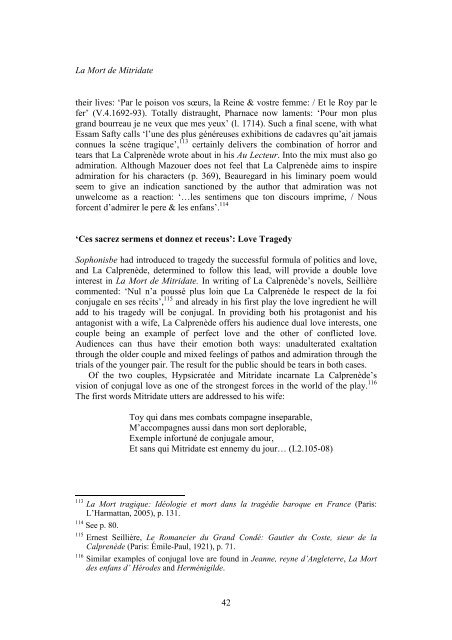LA MORT DE MITRIDATE - University of Liverpool
LA MORT DE MITRIDATE - University of Liverpool
LA MORT DE MITRIDATE - University of Liverpool
Create successful ePaper yourself
Turn your PDF publications into a flip-book with our unique Google optimized e-Paper software.
La Mort de Mitridate<br />
their lives: ‘Par le poison vos sœurs, la Reine & vostre femme: / Et le Roy par le<br />
fer’ (V.4.1692-93). Totally distraught, Pharnace now laments: ‘Pour mon plus<br />
grand bourreau je ne veux que mes yeux’ (l. 1714). Such a final scene, with what<br />
Essam Safty calls ‘l’une des plus généreuses exhibitions de cadavres qu’ait jamais<br />
connues la scène tragique’, 113 certainly delivers the combination <strong>of</strong> horror and<br />
tears that La Calprenède wrote about in his Au Lecteur. Into the mix must also go<br />
admiration. Although Mazouer does not feel that La Calprenède aims to inspire<br />
admiration for his characters (p. 369), Beauregard in his liminary poem would<br />
seem to give an indication sanctioned by the author that admiration was not<br />
unwelcome as a reaction: ‘…les sentimens que ton discours imprime, / Nous<br />
forcent d’admirer le pere & les enfans’. 114<br />
‘Ces sacrez sermens et donnez et receus’: Love Tragedy<br />
Sophonisbe had introduced to tragedy the successful formula <strong>of</strong> politics and love,<br />
and La Calprenède, determined to follow this lead, will provide a double love<br />
interest in La Mort de Mitridate. In writing <strong>of</strong> La Calprenède’s novels, Seillière<br />
commented: ‘Nul n’a poussé plus loin que La Calprenède le respect de la foi<br />
conjugale en ses récits’, 115 and already in his first play the love ingredient he will<br />
add to his tragedy will be conjugal. In providing both his protagonist and his<br />
antagonist with a wife, La Calprenède <strong>of</strong>fers his audience dual love interests, one<br />
couple being an example <strong>of</strong> perfect love and the other <strong>of</strong> conflicted love.<br />
Audiences can thus have their emotion both ways: unadulterated exaltation<br />
through the older couple and mixed feelings <strong>of</strong> pathos and admiration through the<br />
trials <strong>of</strong> the younger pair. The result for the public should be tears in both cases.<br />
Of the two couples, Hypsicratée and Mitridate incarnate La Calprenède’s<br />
vision <strong>of</strong> conjugal love as one <strong>of</strong> the strongest forces in the world <strong>of</strong> the play. 116<br />
The first words Mitridate utters are addressed to his wife:<br />
Toy qui dans mes combats compagne inseparable,<br />
M’accompagnes aussi dans mon sort deplorable,<br />
Exemple infortuné de conjugale amour,<br />
Et sans qui Mitridate est ennemy du jour… (I.2.105-08)<br />
113 La Mort tragique: Idéologie et mort dans la tragédie baroque en France (Paris:<br />
L’Harmattan, 2005), p. 131.<br />
114 See p. 80.<br />
115 Ernest Seillière, Le Romancier du Grand Condé: Gautier du Coste, sieur de la<br />
Calprenède (Paris: Émile-Paul, 1921), p. 71.<br />
116 Similar examples <strong>of</strong> conjugal love are found in Jeanne, reyne d’Angleterre, La Mort<br />
des enfans d’ Hérodes and Herménigilde.<br />
42
















